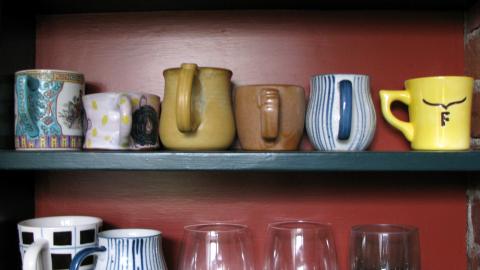Profile of a Coffee Break in Fremont, Michigan
0 comments
96 views

They’re keepin’ it real at the Coffee Break ministry in Fremont, Michigan. To help attendees and leaders walk in the sandals of the people in the Bible stories, Director and Small Group Leader Julie Baker uses maps, photographs, and her experiences in the Middle East to set each story in the time and place in which it occurred. Here’s how she does it:
Each of the small groups who attend this Coffee Break study the same Bible story at the same time. Every week Julie arranges a table with maps, photos, and artifacts that connect to the topic of the day for participants to look through as they arrive and while they have coffee and connect with one another. Prior to dividing into small groups, Julie walks the large group through a map to show the location of the Bible story and to provide any other relevant information. For example, Julie might use a map to trace the movements of Saul and David in order to show how the established roads and terrain caused them to move in a particular way. Or she might display an aerial view poster of the place where David fought Goliath in order to provide people with a bird’s eye view of the battleground. By laminating these resources, Julie is able to use a washable marker and trace the travels of Biblical characters and she describes them to the group. Having traveled in the Middle East, Julie is also able to give the group firsthand descriptions of the sights, smells, and sounds of the Holy Land. The images, maps, and descriptions of her experiences set the stories in a particular time and place for the participants, bringing the story to life as they understand the context in which the stories occurred or were written. How about you? How might you do something similar in your own Coffee Break ministry via technology or guest speakers?
But at this Coffee Break ministry the leaders do more than consider the biblical footprints in the sand—they also carry each other on the journey. For years, the CRC pastors in this rural community, with a population around 5,000, have emphasized the need for churches to reach out and support one another. Looking back over historical documents that tell the story of Coffee Break in Fremont, Julie says that she can see how God has long been at work fostering the “cooperative spirit” that exists among the congregations of the community. As a result, although Coffee Break is held in the Second CRC building, the program does not belong to Second CRC; rather it is a co-owned, cooperative ministry in which Bible study leaders, Story Hour leaders, and child care providers come from four area churches: First CRC, Second CRC, Trinity CRC, and Reeman CRC. It’s a wonderful model to consider if you’d like to offer a Coffee Break ministry in your area but are short on space or people. God fostered a cooperative spirit among the congregations in Fremont—what has God been fostering in your congregation and wider community? How might that bless your Coffee Break ministry?
What does your Coffee Break look like? We’d love to get your mug shot and profile it! Tell us all about your ministry here.
Global Coffee Break, Evangelism
Global Coffee Break
Global Coffee Break, Church Planting
Connect to The Network and add your own question, blog, resource, or job.
Add Your Post
Let's Discuss
We love your comments! Thank you for helping us uphold the Community Guidelines to make this an encouraging and respectful community for everyone.